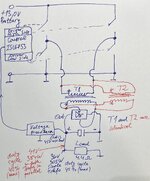AnalogTech
Newbie

Dear Friends of Electronics,
I am developing a car battery powered full-bridge DC/DC converter with a pulse transformer and so far I have managed to convert around 305 Watt on 4.4 Ohm load with good efficiency, also been able to close the feedback loop, got it stable so far so good.
The issue I can’t get my head around is that, I produced the same exact pulse transformer which also on its own delivers around the same power 305 Watt with practically identical efficiency, but upon paralleling both transformers both in terms of primaries and secondaries (both transformers have a single primary and a single secondary) I don’t get significant power increase, instead only around 80 Watt surplus for a total of 384 Watt with slightly higher efficiency than with a single transformer.
This way with single transformer upon 4.4 Ohm loading, the output drops from 45V to 36V or 305 Watt and when the two transformers are paralleled the output drops when loaded from 45V to 41V at 4.4 Ohms or 384 Watt, which is nothing around the doubling of power or the 600 Watt mark. Because the feedback loop is closed the duty cycle opens up to the maximum 42% (set up by myself) in both cases.
I want to increase the output power and I cannot understand why paralleling two power sources with identical characteristics doesn’t add up properly, does anyone have an experience with this or have any ideas what it could be?
Thanks,
Kind Regards
I am developing a car battery powered full-bridge DC/DC converter with a pulse transformer and so far I have managed to convert around 305 Watt on 4.4 Ohm load with good efficiency, also been able to close the feedback loop, got it stable so far so good.
The issue I can’t get my head around is that, I produced the same exact pulse transformer which also on its own delivers around the same power 305 Watt with practically identical efficiency, but upon paralleling both transformers both in terms of primaries and secondaries (both transformers have a single primary and a single secondary) I don’t get significant power increase, instead only around 80 Watt surplus for a total of 384 Watt with slightly higher efficiency than with a single transformer.
This way with single transformer upon 4.4 Ohm loading, the output drops from 45V to 36V or 305 Watt and when the two transformers are paralleled the output drops when loaded from 45V to 41V at 4.4 Ohms or 384 Watt, which is nothing around the doubling of power or the 600 Watt mark. Because the feedback loop is closed the duty cycle opens up to the maximum 42% (set up by myself) in both cases.
I want to increase the output power and I cannot understand why paralleling two power sources with identical characteristics doesn’t add up properly, does anyone have an experience with this or have any ideas what it could be?
Thanks,
Kind Regards

